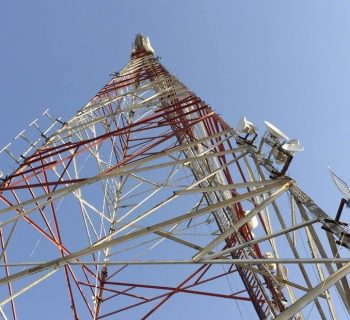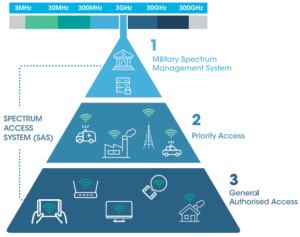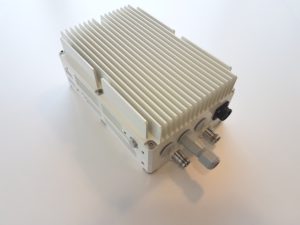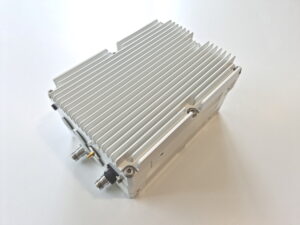Dynamic Spectrum Access for Modern 4G & 5G Networks

CableFree offers a advanced DSA (Dynamic Spectrum Access) for modern 4G and 5G NR & LTE products featuring advanced cellular technology.
CableFree DSA is available as a software layer module for our range of modern radios:
- CableFree 4G & 5G NR Base Stations
- CableFree 4G & 5G Outdoor Small Cells
- CableFree 4G & 5G Indoor Small Cells
CableFree Dynamic Spectrum Access can be used with the range of CableFree range of 5G NR & LTE products to automatically assign operating frequencies, channel width and power levels to ensure interference-free operation and keep spectrum assets clean and uncontended.
What does DSA do?
In a radio network with DSA enabled, there are two essential elements:
- Radio with DSA client agent installed
- Central server (SAS) with knowledge of all the installed radios, and ability to calculate risk/likelihood of interference
When powered up, the radio will start with “transmit mute” (not transmitting) and immediately try to connect to an available SAS over the internet (usually using a wired backhaul connection). When connected to the SAS server, the radio reports it’s location (based on GPS/GNSS receiver in the radio) to the central SAS server, and some other operating parameters. The SAS server checks it’s internal database of existing radios in that region and calculates the risk/probability of any spectrum interference. Providing there are enough unallocated frequencies available , the SAS issues the radio a operating frequency, spectral bandwidth and radio transmit power level to the radio. In unlikely negative case of there being no free channels, the radio is denied permission to transmit.
A more sophisticated DSA system can do interference/RF spectrum scans at all radio sites, and report actual traffic usage from the radio. AI can assist in allocating frequencies based in known and predicted traffic flows on the network. For example, a lightly-loaded cell with low user traffic can be issued a much narrower frequency channel than a high capacity site.

CBRS: an example of DSA
One example of DSA is the CBRS used in the USA. CBRS (band 48) operates in 3550 – 3700MHz. CableFree DSA technology can be used to implement CBRS SAS (Spectrum Access System) with various providers.
CableFree DSA technology can be customised to work in other frequency bands and servers to provide Dynamic Spectrum Access in MNO/Operator bands as well as Spectrum Sharing bands as required for efficient use of spectrum resources. An interesting feature of CBRS is the three-tier system:
When sensors detect federal transmissions, the SAS dynamically reallocates other users in the area to alternative parts of the band. In the second tier, spectrum is allocated to commercial users who buy priority access licenses for a specified location & period of time. At the 3rd tier, remaining spectrum can then be used for general authorized access

Globally, there is increased interest in DSA technology which may be more sophisticated and use more modern technologies, with the goal of ensuring spectrum remains clean whilst maximising usage of finite spectrum resources.
CableFree 5G (gNB, gNodeB) Base Stations

CableFree DSA can work with 5G Software Defined Base Stations (gNB, gNodeB) with advanced features and “stand alone” capability for private networks. When used with our DSA technology, CableFree 5G NR & LTE BS technology offers high capacity, long range networking, using Software Defined Radio technology.
CableFree 5G Base Stations are available as Macrocell and Small Cell (Outdoor and Indoor) versions in all current 5G FR1 bands to meet customer requirements.
CableFree 5G Small Cells

Ideal for use with DSA, CableFree 5G Small Cells are available in the full range of frequency bands with options for Outdoor and Indoor versions (also termed Picocell) in a current 5G FR1 bands.
5G Small Cells are often used as “infill” for additional coverage and capacity in larger networks, or “stand alone” coverage on campus sites and dense city-scale networks.
When using DSA, Small Cells can be automatically configured with operating frequencies and power levels to avoid risk of interference with other cells in the region or network
Software Upgradable from 4G to 5G
Uniquely in the industry, CableFree 5G gNodeB base stations can be software-upgraded from 4G to 5G, (providing in the same frequency band) significantly preserving investment in infrastructure capital expenditure (CapEx). This has advantages with DSA as the radio does not need to be moved or even physically visited for the 4G to 5G upgrade. All can be done remotely, in software.
OpenRAN options
CableFree have options for OpenRAN for private and public networks – please contact us for more information on our O-RAN solutions. CableFree OpenRAN can work with DSA if required.
For Further Information
Please Contact Us for more information on our exciting range of solutions using 5G LTE technology

You must be logged in to post a comment.